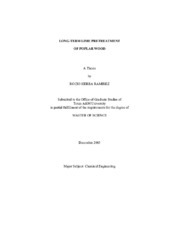| dc.description.abstract | Lignocellulosic biomass (e.g., poplar wood) provides a unique and sustainable resource
for environmentally safe organic fuels and chemicals. The core of this study is the
pretreatment step involved in bioconversion processes. Pretreatment is required to realize
high yields vital to commercial success. The focus of the pretreatment step is to
methodically change key features of the biomass to favor enzymatic hydrolysis.
This work assesses the compositional changes due to oxidative and non-oxidative longterm
lime pretreatment of poplar wood (up to 4 weeks of pretreatment) at mild
temperatures (25ºC to 65ºC), and their effect on the enzymatic yield of glucan and xylan.
The most important pretreatment yield of lignin was 54 g lignin remaining/100 g lignin
in raw biomass, and was accomplished for 4-week lime pretreatment at 65ºC in oxidative
conditions. The corresponding pretreatment yields of glucan and xylan were 85.9 g glucan
recovered/100 g glucan in raw biomass and 80.2 g xylan recovered/100 g xylan in raw
biomass respectively.
For poplar wood oxidatively pretreated with lime for 4 weeks at 65ºC and
enzymatically hydrolyzed with an enzyme loading of 15 FPU/g glucan in raw biomass
during a 3-day period, the best overall yields of glucan and xylan, were 80.7 g glucan
hydrolyzed/100 g glucan in raw biomass and 66.9 g xylan hydrolyzed/100 g xylan in raw
biomass respectively. The corresponding hydrolysis yields were 94.0 g glucan
hydrolyzed/100 g glucan in treated biomass and 83.5 g xylan hydrolyzed/100 g xylan in
treated biomass respectively.
Because there is a previous study of long-term lime pretreatment of corn stover (Kim,
2004), the data obtained in this work show the effect of using woody lignocellulose as
substrate. From the comparison, resulted that in the case of poplar wood oxidatively pretreated at
65ºC for 4 weeks, less lignin was removed and more carbohydrates were solubilized,
however the hydrolysis yield of glucan was almost equal and the hydrolysis yield of xylan
was higher than the reported by Kim for corn stover oxidatively pretreated at 55ºC for 4
weeks. The overall yield of glucan resulted lower in the case of poplar wood because of the
lower pretreatment yield of glucan. Thus, it is important to complete the mass balances
including an analysis on the pretreatment liquor to determine if the solubilized glucan was
degraded. | en |


